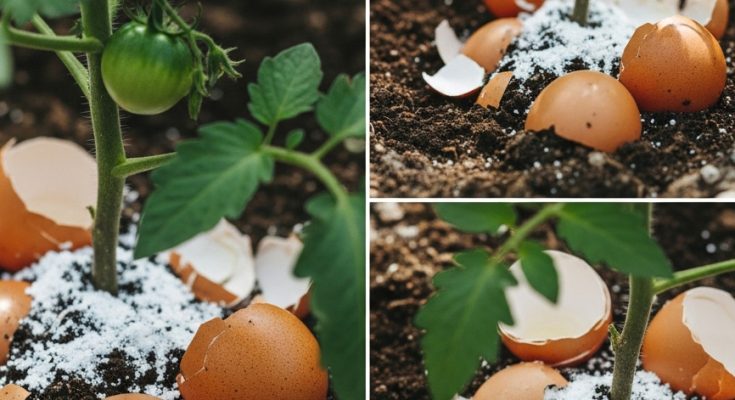One of the most common reasons for this issue is blossom end rot, a condition caused by calcium deficiency in the soil or the inability of plants to absorb sufficient calcium. Fortunately, this can be prevented by enriching the soil with the right nutrients from the beginning. A simple and effective solution is the use of eggshells, which are rich in essential minerals. This article will guide you on how and why using eggshells can make a difference in your garden.
We have previously discussed this issue during the harvesting phase, when the damage is already visible. However, the key to preventing this problem lies in early intervention, particularly during planting and soil preparation. Calcium is crucial for fruit development, and it is best introduced into the soil either at planting or by the early flowering stage. Missing this window may result in poor fruit quality and yield losses.
The symptoms of calcium deficiency usually become apparent in mid-summer during peak harvest. To prevent this, eggshells can be used as a natural calcium supplement. Since eggshells contain 90% calcium, they serve as an excellent organic source of this mineral. Instead of discarding them, you can repurpose them to enhance soil quality.
To prepare eggshells for garden use, they must be thoroughly washed, dried, and crushed into small pieces or ground into powder. This process eliminates any odor and makes it easier for plants to absorb the nutrients. In addition to calcium, eggshells contain other beneficial minerals such as iron, copper, manganese, phosphorus, chromium, molybdenum, magnesium, natural fluorine, and proteins. One teaspoon of eggshell powder provides approximately 800 to 1000 mg of calcium, making it an effective supplement for your plants.
Over time, calcium is leached from the soil due to precipitation and irrigation. Plants also absorb calcium during their growing cycles, gradually increasing soil acidity. By regularly adding calcium to the soil, you can improve soil structure, enhance drought resistance, and enable better nutrient absorption. Calcium plays a vital role in strengthening cell walls, preventing fruit rot, and increasing crop yields.
Vegetables that require high calcium levels for growth include tomatoes, peppers, and eggplants. A deficiency of this mineral can result in blossom end rot, where brown spots appear at the bottom of the fruit and gradually expand. Additionally, calcium deficiency manifests in young plants through leaf chlorosis, slow growth, weak root development, and curled or darkened leaves. If left untreated, plant structures weaken, making them susceptible to disease and environmental stress.
Collecting and using eggshells is a long-term process. It is best to start accumulating them well in advance so they are ready when needed. The ideal time to apply eggshells is during seedling transplantation. Sprinkling crushed eggshells in planting holes provides a slow-release calcium source for young plants. Although nitrogen, phosphorus, and potassium are essential for plant health, calcium is equally crucial for building strong plant tissues.
Since eggshell decomposition takes time, it is advisable to apply them in the fall, allowing sufficient time for calcium to integrate into the soil before the next planting season. To provide immediate calcium to your plants, grind eggshells into a fine powder using a mortar and pestle or a coffee grinder. Mix a small handful of this powder with compost, humus, or manure before planting.
Later in the growing season, additional calcium can be supplied by sprinkling eggshell powder around the base of plants and watering it into the soil. Eggshells can also be incorporated into potting soil or placed at the bottom of containers to enhance drainage and nutrient availability. For a nutrient-rich soil amendment, combine eggshells with nitrogen-rich coffee grounds to improve soil aeration and reduce acidity.
Another effective method is to create an eggshell-infused water solution. Simply place eggshells in a bucket of water and let them sit overnight. The following morning, add coffee grounds in a 1:4 ratio and use this mixture to water your plants. This method ensures a gradual release of calcium while improving soil structure and microbial activity.
Adding crushed eggshells to compost is another way to boost calcium content. As eggshells decompose, they enhance microbial activity and enrich the compost with essential minerals. Additionally, eggshells can be used as mulch around plants to retain soil moisture, suppress weeds, and slowly release nutrients.
For a more potent calcium supplement, eggshells can be dissolved in apple cider vinegar. The acetic acid in vinegar reacts with calcium carbonate in the shells, releasing bioavailable calcium. To make this solution, grind the eggshells and submerge them in vinegar. The mixture will produce foam as the reaction takes place. Allow it to sit for at least 21 days or until the foaming stops. Be sure to cover the container with cheesecloth, but do not seal it tightly, as gas buildup could cause pressure. Once ready, strain the liquid and use it as a foliar spray. Dilute 2-3 tablespoons of the solution in 1 liter of water and spray it onto plant leaves.
Mulching plays an essential role in maintaining soil moisture and nutrient retention. A well-mulched garden enables better calcium absorption and minimizes weed growth. For more details, you can check out our previous discussions on mulching techniques.
Timely calcium supplementation is crucial for plant health. During hot summer months, plants may struggle to absorb calcium from the soil due to high temperatures. In such cases, foliar feeding—spraying diluted calcium solution directly onto leaves—ensures effective nutrient uptake.
As we approach the transplanting season, we will continue sharing tips to keep your plants healthy and resilient. Join us for more gardening insights, and if you found this information helpful, support our work by liking and sharing this article with fellow gardeners. Happy gardening!
